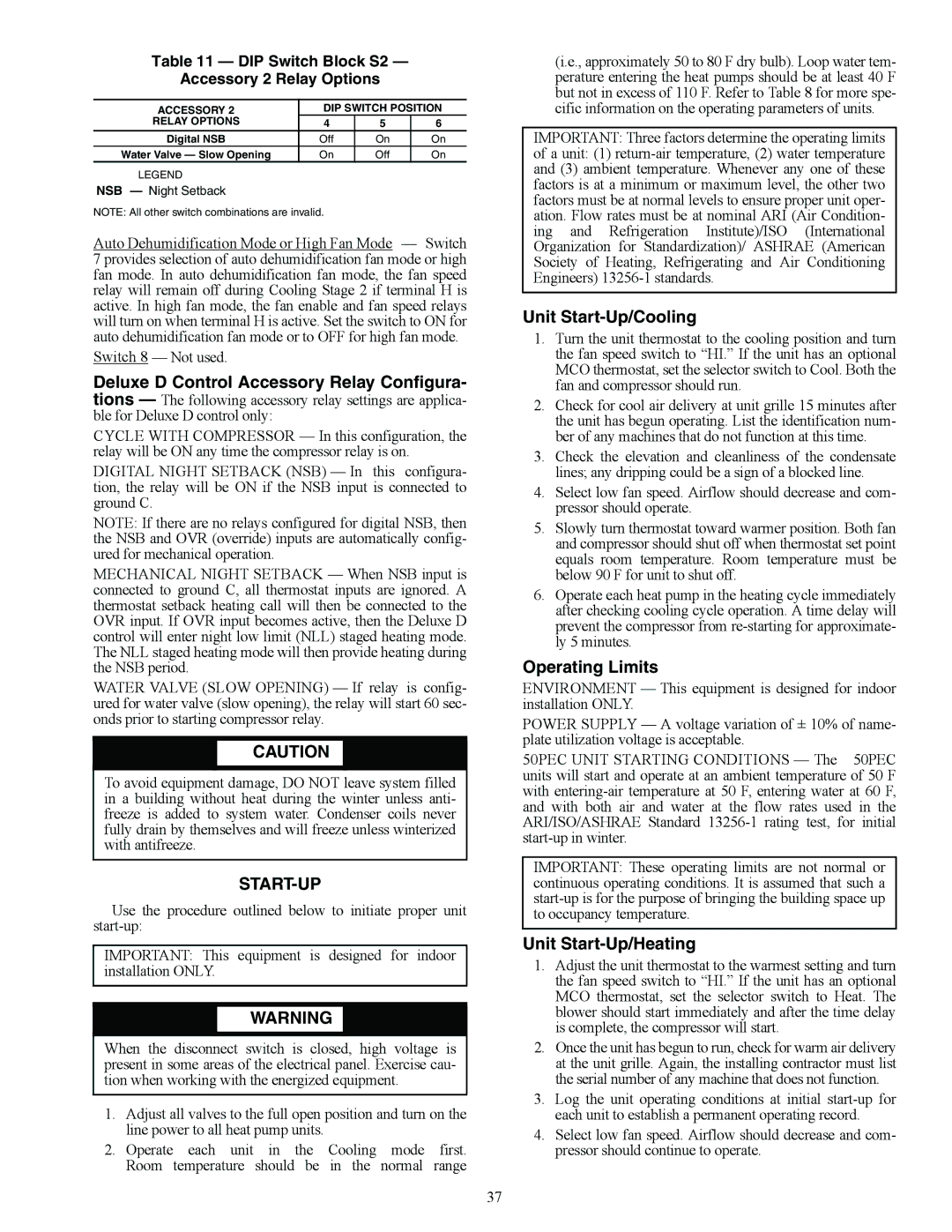
Table 11 — DIP Switch Block S2 —
Accessory 2 Relay Options
ACCESSORY 2 | DIP SWITCH POSITION | ||
RELAY OPTIONS | 4 | 5 | 6 |
Digital NSB | Off | On | On |
Water Valve — Slow Opening | On | Off | On |
LEGEND |
|
|
|
NSB — Night Setback
NOTE: All other switch combinations are invalid.
Auto Dehumidification Mode or High Fan Mode — Switch 7 provides selection of auto dehumidification fan mode or high fan mode. In auto dehumidification fan mode, the fan speed relay will remain off during Cooling Stage 2 if terminal H is active. In high fan mode, the fan enable and fan speed relays will turn on when terminal H is active. Set the switch to ON for auto dehumidification fan mode or to OFF for high fan mode.
Switch 8 — Not used.
Deluxe D Control Accessory Relay Configura- tions — The following accessory relay settings are applica- ble for Deluxe D control only:
CYCLE WITH COMPRESSOR — In this configuration, the relay will be ON any time the compressor relay is on.
DIGITAL NIGHT SETBACK (NSB) — In this configura- tion, the relay will be ON if the NSB input is connected to ground C.
NOTE: If there are no relays configured for digital NSB, then the NSB and OVR (override) inputs are automatically config- ured for mechanical operation.
MECHANICAL NIGHT SETBACK — When NSB input is connected to ground C, all thermostat inputs are ignored. A thermostat setback heating call will then be connected to the OVR input. If OVR input becomes active, then the Deluxe D control will enter night low limit (NLL) staged heating mode. The NLL staged heating mode will then provide heating during the NSB period.
WATER VALVE (SLOW OPENING) — If relay is config- ured for water valve (slow opening), the relay will start 60 sec- onds prior to starting compressor relay.
![]() CAUTION
CAUTION
To avoid equipment damage, DO NOT leave system filled in a building without heat during the winter unless anti- freeze is added to system water. Condenser coils never fully drain by themselves and will freeze unless winterized with antifreeze.
START-UP
Use the procedure outlined below to initiate proper unit
IMPORTANT: This equipment is designed for indoor installation ONLY.
![]() WARNING
WARNING
When the disconnect switch is closed, high voltage is present in some areas of the electrical panel. Exercise cau- tion when working with the energized equipment.
1.Adjust all valves to the full open position and turn on the line power to all heat pump units.
2.Operate each unit in the Cooling mode first. Room temperature should be in the normal range
(i.e., approximately 50 to 80 F dry bulb). Loop water tem- perature entering the heat pumps should be at least 40 F but not in excess of 110 F. Refer to Table 8 for more spe- cific information on the operating parameters of units.
IMPORTANT: Three factors determine the operating limits
of a unit: (1)
Unit Start-Up/Cooling
1.Turn the unit thermostat to the cooling position and turn the fan speed switch to “HI.” If the unit has an optional MCO thermostat, set the selector switch to Cool. Both the fan and compressor should run.
2.Check for cool air delivery at unit grille 15 minutes after the unit has begun operating. List the identification num- ber of any machines that do not function at this time.
3.Check the elevation and cleanliness of the condensate lines; any dripping could be a sign of a blocked line.
4.Select low fan speed. Airflow should decrease and com- pressor should operate.
5.Slowly turn thermostat toward warmer position. Both fan and compressor should shut off when thermostat set point equals room temperature. Room temperature must be below 90 F for unit to shut off.
6.Operate each heat pump in the heating cycle immediately after checking cooling cycle operation. A time delay will prevent the compressor from
Operating Limits
ENVIRONMENT — This equipment is designed for indoor installation ONLY.
POWER SUPPLY — A voltage variation of ± 10% of name- plate utilization voltage is acceptable.
50PEC UNIT STARTING CONDITIONS — The 50PEC units will start and operate at an ambient temperature of 50 F with
IMPORTANT: These operating limits are not normal or continuous operating conditions. It is assumed that such a
Unit Start-Up/Heating
1.Adjust the unit thermostat to the warmest setting and turn the fan speed switch to “HI.” If the unit has an optional MCO thermostat, set the selector switch to Heat. The blower should start immediately and after the time delay is complete, the compressor will start.
2.Once the unit has begun to run, check for warm air delivery at the unit grille. Again, the installing contractor must list the serial number of any machine that does not function.
3.Log the unit operating conditions at initial
4.Select low fan speed. Airflow should decrease and com- pressor should continue to operate.
37
